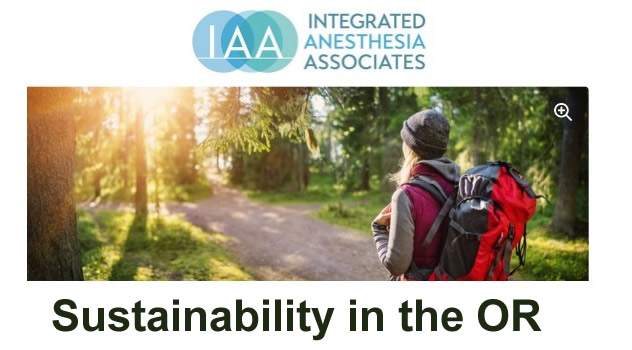
PART 2
In our previous Sustainability in the OR blog post, we discussed the importance of total fresh gas flow reduction during inhalational anesthesia maintenance. If you haven’t done so already, we highly recommend reviewing the total fresh gas flow reduction information and completing the APSF low-flow anesthesia module.
In today’s blog (which I’m inclined to call a “prequel”) we’ll discuss a few very important practice changes involving inhaled anesthetics that can further reduce our impact on the environment.
When choosing to deliver an anesthetic gas:
RESIST ALL URGES TO USE DESFLURANE
This volatile anesthetic is around 20 times worse than SEVOFLURANE as a Greenhouse Gas (GHG). DES has a more severe impact due to its higher MAC, its intrinsic properties as a GHG, and its fourteen-year lifetime in the atmosphere.
Many hospitals have removed DES from their formulary since its minimal advantages are far outweighed by its harm to the environment. PLUS, we are all capable of orchestrating quick “wake-ups” without using Desflurane.
BREAK YOUR N2O HABIT
WHY it’s important:
N2O is not just 2.5X worse than SEVO as a GHG, but it also directly depletes the ozone layer in a fashion similar to that of the CFCs in the spray cans and refrigerants of the 70s and 80s. In addition, N2O has a > 100-year lifetime in our atmosphere.
HOW to break the habit
1. If you want to add a little supplemental anesthetic gas to your TIVA, please use 1/4-1/2 MAC SEVO instead of N2O.
2. If you want to limit your Sevoflurane concentration during inhalation-based general anesthesia, start a propofol infusion instead of turning on the N2O.
3. When a regional anesthetic block has been performed, resist the temptation to turn on N2O in addition to TIVA. You will most likely observe that you don’t need the N2O.
A propofol infusion on its own is usually all that is needed with a good working regional block.
4. Recognize that aside from inhalational inductions (primarily for pediatric cases) and general anesthesia for cesarean sections, the use of N2O has no meaningful advantage.
:: TODAY’S TAKEAWAY :: Stick with Sevoflurane
Subscribe to our Sustainability in the OR e-newsletter
You can unsubscribe at any time, share with your colleagues and never miss an issue.Learn more about IAA’s sustainability initiative at
www.iaapartners.com/sustainability
Join us & spread the word
As always, thank you to all my colleagues both near and far. I have personally seen a marked change in our utilization of our volatile anesthetics, as well as attempts to reduce our waste streams. As we all benefit from daily efforts, our descendants are benefitting every day as well. As has been said by many individuals in various ways, “We did not inherit this earth . . . . we are borrowing it from our children.”
Do you have a success story you would like to share? Please use the contact information below and get in touch. I would love to hear from you.
Until next time, thanks for your continued interest and efforts!
Adam
 Adam Fischler, M.D.
Adam Fischler, M.D.
Integrated Anesthesia Associates
Assistant Clinical Professor, Department of Anesthesiology, UCONN Health
Medical Director of the OR, UCONN Health
Section Chief, Regional Anesthesia
Section Chief, Sustainability
iaapartners.com/sustainability
adam.fischler@iaapartners.com
860-679-2744
APSF low-flow anesthesia education |
| Become a low-flow anesthesia expert and earn CME’s!
Go to the APSF Education Modual >>
Low-Flow Anesthesia – Anesthesia Patient Safety Foundation Please complete this excellent activity and gradually apply what you have learned to your practice. |

